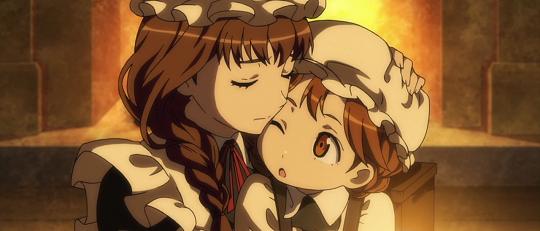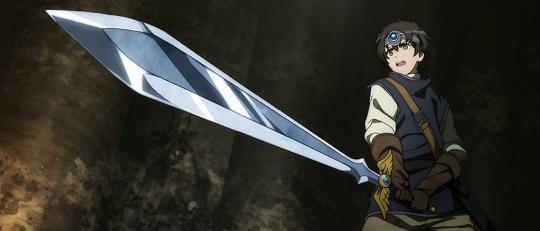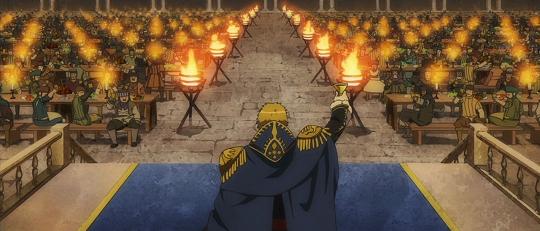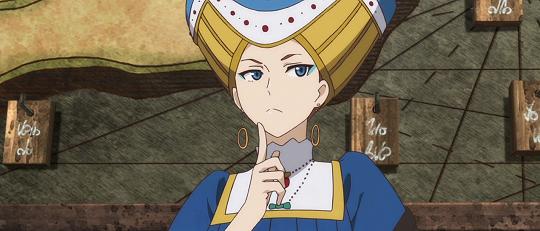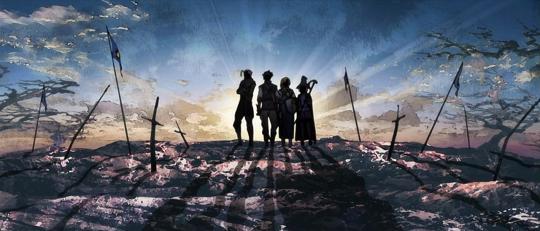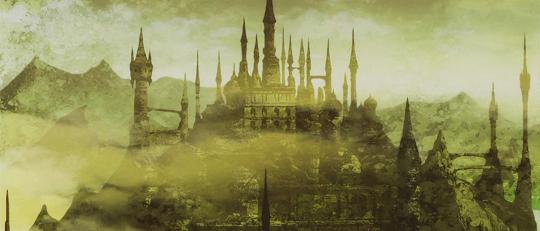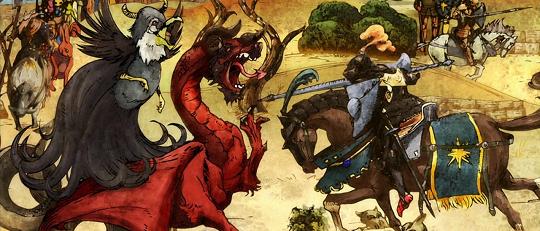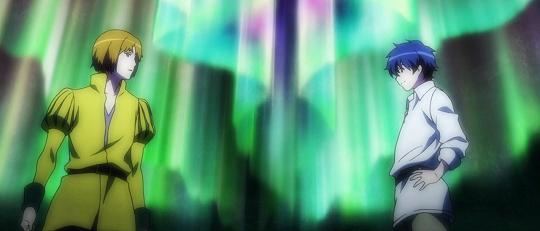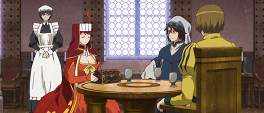Maoyuu Maou Yuusha (Demon King and the Hero) was nothing like what I expected. My ill-advised method of choosing anime to watch based on animated GIFs that I find on Tumblr led me to believe it was going to be just another medieval fan-service series; sharpen claws, commence slating. How wrong I was. I had seen the first episode when the series first aired and didn’t continue watching for some unknown fickle reason but frequently heard it compared to Spice and Wolf. In that series, wolf spirit Holo wanders around naked for a not insignificant amount of time which is likely where I assumed the comparison came from.
In actuality it’s from the pointed approach to medieval affairs than chest out fan-service; so whereas Spice and Wolf busies itself with the minutiae of trade economics, Maoyuu Maou Yuusha goes for a more nuts-and-bolts cultural approach, dragging in some good old fashion politicking to go with it. You have the Demon King, the red haired poster child of the series, who makes a deal with the Hero, Generic McBlandpants, to set aside their racial and ideological differences in order to build a better world.
Those aren’t just their titles by the way, those are actually how the characters refer to each other which gets slightly confusing when you have a multitude of maids resulting in them being labelled “younger sister maid”, “elder sister maid” and “head maid”. This situation stems back to the series’ genesis as a play-format story posted on that crucible of creativity, 2ch. Eventually making its way to a collection of light novels and no less than five manga series (four of which are still going) and then the anime, it’s strange to not only be able to overlook the lack of names but for the characters to evolve into something greater than their titles and better than their archetypes.
So the titular Demon King could have easily been played as a fan-service character which, initially at least, seems to be the way the series is going with her possessing a body pillow of the Hero and frequent early episode... interactions with her chest. Likewise the Hero, a walking paradigm of strength and virtue, could have remained a cipher or, at worst, a self-insert for the audience. Yet in both cases their personalities are developed with depths that belie their introductions. The Demon King becomes the Red Scholar, first playing Sir Francis Drake’s role in introducing the potato while simultaneously proliferating the idea of crop rotation as well as, eventually, taking on Gutenberg’s role with a movable type printing system. The Hero meanwhile, despite being described as a “singularity” within the world’s lore, is shown to be wary of his abilities and the isolation they bring yet he yearns for something more than just destroying.
It’s a fascinating progression for the characters and not limited to the two protagonists, going as far as giving Elder Sister Maid her time in the spotlight in a thoroughly unexpected way. Unexpectedness is part of the series charm though, and not in the razzle-dazzle Code Geass method of rapidly escalating lunacy, but in a genuine “this could go either way” manner. A lot of this is thanks to the appreciable amount of time the series covers with weeks, sometimes months, passing between episodes reinforcing the idea that nothing happens quickly in this age and change takes time, even when you’re dealing with dragon ladies and teleportation. Yes even though the hero can zip about the countryside with gay abandon, he still spends a large portion of time away from his belle the Red Scholar, only for him to return and for her to abscond to the “demon realm”.
It’s a smart move because it naturally allows the story to take a dramatic turn without events undermining her planning and obvious intelligence. It also provides an emotional climax of the series even though it’s not the same as the plot one. The demon realm itself is, like the world as a whole, presented “as is” and it’s left as an exercise for the viewer to accept that dolphin people and giant walruses will be treated with as much seriousness as the outwardly human looking and aforementioned dragon lady. On that note, the series unfortunately isn’t immune to anime tropes and it isn’t long before the Hero has not only the Red Scholar but also a knight of the church and numerous females of the demon realm fawning over him, culminating in a rather bizarre take on “three in a bed”.
With a couple of exceptions, it’s all rather good natured and is indicative of how easy it is to paper over some of the more egregious visual and narrative failings when the rest of the series has its priorities straight. So there is an implicit expectation that the audience will work with the series to keep everyone’s roles and past actions in mind, even when their names are omitted and their origin is obfuscated through the series’ use of a mythical alphabet (despite the internet leaping to decipher it). It means that early on, even when locations are shown in cuts to an old parchment style map, their relation to other regions is tenuous at best; but by the time the series is coming to a close and battle lines are being drawn, episodes dash between locales in quick succession. And, for the most part, it all manages to make sense.
That’s impressive when you’ve spent two thirds of your runtime and over a year of story time maneuvering demons and kings and merchants and soldiers into position, then letting them all collide. The Red Scholar’s rise to prominence is reminiscent of Berserk’s Golden Age story arc and Griffith’s similar rise to power, and it comes with the same kind of noble scorn and pompous derision that he suffered. The series is thankfully smart enough to not simply leave a farming solution at “crop rotation!” (looking at you here No Game No Life) and be done with it, indeed it’s down to the Red Scholar to drag the world into a nascent renaissance with all of her ideas - wherever they come from.
It’s a fine line to walk and Maoyuu Maou Yuusha does it with unexpected assuredness. So whereas other series would bog you down with fictional historical details, Maoyuu launches you straight into the meat of its story and expects you to infer what you need. This does mean that certain elements - like the female mage’s triple personality or the mysterious earthquakes that plague the Red Scholar’s village - are never explained coupled with scenes during the final wrap up that obviously allude to future events in the light novels. But then you get aspects like the treatment of the story’s religion, a representation of Catholicism in all but name: it chastises the blind dogmatism of some of its adherents but never dismisses piety, only demonstrating that without humanity it’s just as bad as the nefarious machinations of the royals.
Perhaps then an argument, if indeed it was needed, for not judging a series by, ahem, pendulous GIFs. It steps beyond it’s initial hook and anime favourite of turning dread personalities into busty females and goes much further than “I’m here to kill you!” “You want some tea?” “...” “...” “Sure”. There is an awful lot to love in Maoyuu Maou Yuusha and its uniqueness of approach - no names, oblique locations, passage of time - plays a large part in that. It’s fair to say that after viewing, the comparison to Spice and Wolf is somewhat justified. Unlike that series though you don’t have to have an intimate appreciation for medieval life (economics or otherwise) to get the most out of it. There are battles, though somewhat haphazardly rendered despite the pleasing watercolour backdrops, magic and intrigue as much as there are mercantile shenanigans. It’s perhaps cliche when speaking about anime, but if you are looking for something different to the norm, then you could do a lot worse than Maoyuu Maou Yuusha.

